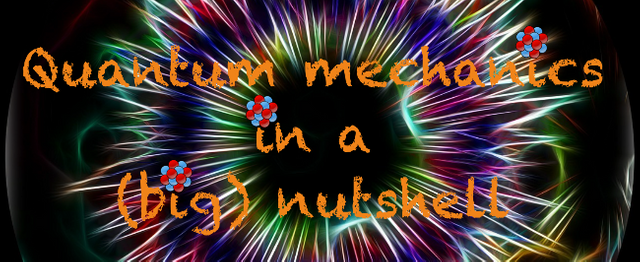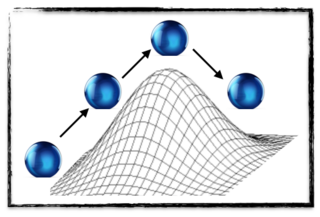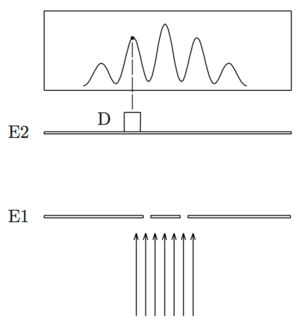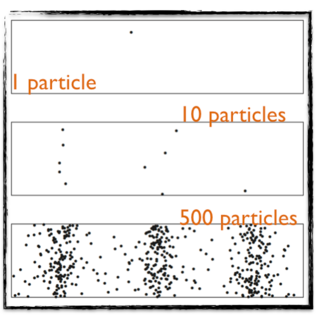Wave-particle duality aka the central pillar of quantum mechanics

In two of my last posts on quantum mechanics, I introduced the concept of the wave-particle duality.
I have discussed that light (or actually waves) can exhibit the behavior of a particle (see here) and that inversely, a wave could be associated with a particle like an electron (see here).
Since this is a central pillar in quantum mechanics, I would like to dedicate a full blog post to it, in particular to emphasize the differences between the classical physics case (where the world is not quantized), and the quantum case.
Classical physics (or in other words, non-quantum physics), is based in two distinct concepts: particles and waves. The important word here is ‘distinct’. Particles and waves have nothing to do with each other.
This is not of course not the case anymore for quantum mechanics. With this respect, the works of Einstein, Planck and de Broglie were really a revolution in our understanding of how the world works.
CLASSICAL PARTICLES
Let us start with a classical particle, like the blue ball from the picture of the right that rolls towards the top of a hill and that will go down after reaching the summit.
What is going on there results from some action that happened in the past. For instance, someone may have kicked that ball out strongly enough so that it can go up to the top of the hill.
In classical physics, this ‘ball-particle’ is assimilated to a material point of a given mass. The action of the environment (our initial kick) is assimilated to forces, and the fundamental principle of dynamics allows us to calculate the trajectory of the particle and what is happening to it.
The very important point is that the particle always occupy a well determined position in space at any well determined moment.
Futhermore, This simplistic picture can be generalized to many particles interacting with each other, as well as to solid and fluids.
CLASSICAL WAVES
In classical physics, the notion of waves appears when one tries to model continuous phenomena, like ripples on water or sound in the air.

[image credits: Wikipedia]
A synonym to a wave is the notion of a classical field. Two well-known examples of fields acting in our everyday lives are the gravitational and the electromagnetical fields.
The key property of the fields (or waves, as these are the same things) is that they are known to propagate both in space and in time.
To explain this better, we can study the location of one of the crests of the ripples shown on the picture on the left.
A crest moves in space from the center to the outside, and this is nothing but the propagation of the wave in space.
Similarly, the location of a crest at a given moment does not stay the location of a crest forever. After a short moment, there is no crest anymore there, and after a longer moment, the crest is back there. This consists of propagation in time.
UNIFICATION WITH QUANTUM MECHANICS
In quantum mechanics, the concepts of waves and particles are unified. What we usually call a ‘particle’ is actually both a particle in the sense of the classical ball, as well as a wave in the sense of the ripple.
In order to understand that better, it is good to restart from the double-slit experiment of the previous post.
To sum up what is going on in there, particles are sent through the two slits, as shown on the picture.
Considering these particles as classical objects, they should pass either through the first slit of through the second one and one should thus detect two well-localized spots on the second screen E2.
This is however not what we get, and we observe on the screen E2 an interference pattern typical from a wave.
There are two questions we can ask here.
How is it possible to conciliate an wavy interference pattern with the fact that we throw particles one by one through the slits, and by which slit a given particle goes through.
To answer to the first question, one must keep in mind that particles arrive on by one on the E2 screen and it is only when many particles have been sent that the interference pattern shows up.
To clarify it, we can check the picture on the left.
When the first particle arrives to the screen (upper panel), one gets a well-defined spot on the screen.
After 10 particles (central panel), one gets 10 well-defined spots. And so on…
However, after a larger number of particles (lower panel), we observe zones with a maximum of hits and zones with almost no hit at all.
Here is our interference pattern. It is a point-like way to see a wave.
Concerning the second question of the slit through which a given particle passes, it is trickier. If we remove one of the slits, one only gets a single spot on the screen and there is no more interference.
There is solely one possible conclusion to this: the particles are going through both slits at the same time, and the probability to get a hit here or there is then linked to the properties of the wave associated with our particles.
DISCUSSION AND REFERENCES
With this post, I wanted to come back a little bit to one of the greatest pillars of quantum mechanics: the wave-particle duality.
I started this blog post with some basics about classical physics, where waves and particles are different concepts that are not talking with each other.
In quantum mechanics, the story is different. Both concepts are unified: a wave is associated with each particle and a particle is associated with each wave.
And actually, one interesting point is that we do not care whether the particle is massive or massless. Which is good as one cannot in principle measure precisely that a particle is massless (one can only establish that the mass of a particle is smaller than some threshold). We indeed do not want to have sharp transitions in the predictions when we take the limit of masses going to zero. But this is another story!
For more information (and references), one can check either this book, or the wave-particle duality Wikipedia page that contains plenty of details.
Table of contents of this series of posts
I. Introduction
1. Concepts and fundations
2. Interactions and conservation laws
3. Systems of particles
II. The origins of quantum mechanics
1. Fundamental physics at the beginning of the 20th century
2. The mysteries of the atomic spectra
3. The mysteries of the black bodies
4. Quantization of the electromagnetic radiation and the birth of the photons
5. The Compton effect
6. The planetary model of the atom
7. The Bohr model of the atom
8. Matter waves
9. More on the wave-particle duality (this post)
For more discussion on this topic (or anything related to science), please join us on steemSTEM. SteemSTEM is a community driven project which seeks to promote well written/informative Science Technology Engineering and Mathematics postings on Steemit. More information can be found on the @steemstem blog.



Thanks to you :)
So, it's like, let's say, two air bubbles merging? I mean, the reason they only show as one spot, is because, after passing through the slit, the particles somehow draw each other to the same place, and become one, and then hit the screen? I know this is probably not what 'really' happens, I'm just trying to describe it in a 'human' or intuitive way, as an analogy.
It is really hard to imagine, with our human brain, what is going on. There were many attempts trying to get the exact track followed by the particles to understand through which slit they went. And those attempts were much more clever than just closing one slit. However, at each time, the interferences disappeared.
I am feeling a bit uncomfortable with your analogy. It is better to see it as a wave and that's it.
In our physics class at school we studied this and the teacher told us that it was due to wave-particle duality, but that it was hard to understand so we couldnt get to it.
I still don't understand how a single photon can travel in all directions at once. I half understand that the wave is just the potential for the photon to exist, and on interaction the wave 'collapses' into a particle state, but if you have a better explanation I'd be pleased to read it.
A single photon (particle) cannot. It is a particle and has a given energy-momentum. In other words, the direction of the momentum is well determined. This is different from the photon quantum field.
In contrast, the photon field is indeed everywhere in spacetime, and photons are seen as quantized oscillations in this field. In other words, what we call particle is a quantization effect. But usually, we use one for the other which increases the confusion.
I am not sure whether this helps, but maybe can you expand the question?
OK so I was given bad info (or misunderstood).
So my interpretation of the two slit experiment is as follows.
Photon leaves the emission source
Photon wave potential encounters 2 slits
Photon collapses into particle and passes via one slit
Photon becomes a wave potential again and received some amount of diffraction
Photon travels towards screen on new trajectory
Photon reaches screen and collapses back into a particle
Your interpretation is actually not correct.
The particle and the wave are always coming as pairs. It is never one or the other, but always one and the other.
It is also not possible, as said at the end of the article, to determine by which silt the particle went through. The interpretation is really tough and counterintuitive, I know ;)
Ok yes my explanation wasnt exactly what I meant, the particle and the wave are different expressions of the same thing, I mean more that the wave/particle behaves as if it were a wave or particle based on the scenario, but the underlying object itself doesnt change. A man can wear a blue hat or a red hat, he is still a man with two hats, which hat he is wearing at a given time depends on the occasion.
In terms of the slit, I wasnt saying we could observe which slit the photon passes through (if we do there is no interference pattern, I think, the act of observation changes the outcome), only that it expresses itself as a particle in that scenario and passes through one slit or the other.
That's the difficulty of chatting on the comments of a post and not lively. Let's try to do our best in understanding each other ;)
This is however the question that cannot be answered. It is really like the particle passes through both slits at the same time, which is very counterintuitive. If the particle would pass through a single slit, then we would not get any interference pattern.
'It is really like the particle passes through both slits at the same time', yes and its where I get fuzzy, but I think we kind of believe it passes through both with a chance.
So if it passes through slit 1 with a 55% potential then we will see more interference on that side, but anyway it also went through slit 2 with a 45% potential. We always get the particle come out of the slits, but we cant be clear which one, but everything adds back up to 100% in the end. So we know it did happen, just not exactly how.
We are indeed getting closer. it is only the potential fractions that I don't understand. Do you mind explaining them further? thanks in advance!
Conceptually, this is hard to digest. But this is actually the key. Even if one may think this is not possible, data is there to tell us that it actually works.
Then Feynman comes around and asks:
And suddenly you have discovered the path integral :D
I have never thought about it that way Naively, I would said yes, it works :D
I'm not sure whether this is a factual anecdote but this is what Feynman is supposed to have asked his professor back then.
And mathematically rigorously speaking this is how you could construct a path-measure (compare Wiener measure for Brownian motion). It might have been a very educated question if this is really true :D
:)
I am about half way through the post but I have to go and do something (I wanted something commented so I could easily find my way back here) Anyways I have a couple of comments to make but I shall wait until I am finished. So far it is a good read, I like it.
Anyways @lemouth I was curious about something involving the double slit experiment. When discussed in my high school textbook it stated that there we points of complete cancellation (nodes) but with the graph that you have posted it shows that it never actually hits 0. I am just curious if there are points of complete interference or if it just has positions of maximum and minimum probability?
The interference pattern does not necessarily means that the minimum is zero. It could be but this is not necessarily the case. What is important is that you have regions with many points (constructive interferences) and region with not that many points (destructive interferences).
Also here, note that the figure is homemade, so that one could get the feeling of what is going on. It is not at all meant to be precise :p
Okay thank you, sorry. The post is very well written!
Don't be sorry! I always like comments, questions and discussions :)
You touched on all of the important points here. The double-slit experiment is still one of the most intriguing things that I have seen.
Have you experienced it by yourself? It is really cool, believe me :)
Yes, it is quite amazing.
I just read a small post about quantum mechanics from a fellow newbie. It didn’t quite sound right or fill that need for info so I searched quantum mechanics on steemit. I LOVE this subject and am glad I found your stuff on the subject. You’re articles are going to become a part of my daily ritual. 😊 I’m excited to learn from you.
Thank you for your nice message.
If you want, you can message me (on the steemit chat, I am in the steemstem channel for instance) the link and we can have a look together to the other article. I would be more than happy to message the author and points the errors.
For sure! I haven’t had much time to be on this weekend so it’ll probably be Monday. Look forward to it.
Thanks! I got your message on the steemit chat. If you want, we can continue chatting there. However, please be prepared for some lag... I am organizing a workshop this week and the next one, and my time is very limited. I will nevertheless try to do my best to answer as quickly as possible.
Not a problem. My time is quite limited too so I know how that goes.
:)
just loved your work on the homemade images ! :)
This actually takes a substantial amount of time, believe me. I am happy you like the images (and thus the effort :p),
Thanks for this post. I was previously reading the first chapter of a book about quantum physics. I went... and your post reminded me to go back into this interesting subject...
The book in reference is actually in French, if you are interested by quantum physics :)
Congratulations @lemouth, this post is the tenth most rewarded post (based on pending payouts) in the last 12 hours written by a Hero account holder (accounts that hold between 10 and 100 Mega Vests). The total number of posts by Hero account holders during this period was 232 and the total pending payments to posts in this category was $2951.93. To see the full list of highest paid posts across all accounts categories, click here.
If you do not wish to receive these messages in future, please reply stop to this comment.